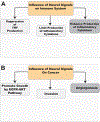Can neural signals override cellular decisions in the presence of DNA damage?
- PMID: 33990031
- PMCID: PMC8876969
- DOI: 10.1016/j.dnarep.2021.103127
Can neural signals override cellular decisions in the presence of DNA damage?
Abstract
Cells within an organism are in constant crosstalk with their surrounding environment. Short and long-range signals influence cellular behavior associated with division, differentiation, and death. This crosstalk among cells underlies tissue renewal to guarantee faithful replacement of old or damaged cells over many years. Renewing tissues also offer recurrent opportunities for DNA damage and cellular transformation that tend to occur with aging. Most cells with extensive DNA damage have limited options such as halting cell cycle to repair DNA, undergo senescence, or programmed cell death. However, in some cases cells carrying toxic forms of DNA damage survive and proliferate. The underlying factors driving survival and proliferation of cells with DNA damage remain unknown. Here we discuss potential roles the nervous system may play in influencing the fate of cells with DNA damage. We present a brief survey highlighting the implications the nervous system has in regeneration, regulation of stem cells, modulation of the immune system, and its contribution to cancer progression. Finally, we propose the use of planarian flatworms as a convenient model organism to molecularly dissect the influence of neural signals over cellular fate regulation in the presence of DNA damage.
Keywords: Animal models; DNA damage response; Nervous system; Neural regulation; Planarians; Stem cells.
Copyright © 2021 Elsevier B.V. All rights reserved.
Conflict of interest statement
Conflict of Interest Statement
The authors declare there is no conflict of interest.
Figures



Similar articles
-
DNA damage and tissue repair: What we can learn from planaria.Semin Cell Dev Biol. 2019 Mar;87:145-159. doi: 10.1016/j.semcdb.2018.04.013. Epub 2018 May 3. Semin Cell Dev Biol. 2019. PMID: 29727725 Free PMC article. Review.
-
Regional signals in the planarian body guide stem cell fate in the presence of genomic instability.Development. 2016 May 15;143(10):1697-709. doi: 10.1242/dev.131318. Epub 2016 Mar 24. Development. 2016. PMID: 27013241 Free PMC article.
-
Stem cells and regeneration in planarians.Front Biosci. 2008 May 1;13:6374-94. doi: 10.2741/3160. Front Biosci. 2008. PMID: 18508666 Review.
-
The Cellular and Molecular Basis for Planarian Regeneration.Cell. 2018 Oct 4;175(2):327-345. doi: 10.1016/j.cell.2018.09.021. Cell. 2018. PMID: 30290140 Free PMC article. Review.
-
The Akt signaling pathway is required for tissue maintenance and regeneration in planarians.BMC Dev Biol. 2016 Apr 11;16:7. doi: 10.1186/s12861-016-0107-z. BMC Dev Biol. 2016. PMID: 27068018 Free PMC article.
Cited by
-
Non-coding genetic elements of lung cancer identified using whole genome sequencing in 13,722 Chinese.Nat Commun. 2025 Aug 9;16(1):7365. doi: 10.1038/s41467-025-62459-6. Nat Commun. 2025. PMID: 40783572 Free PMC article.
References
-
- Lodovichi S, Bellè F, Cervelli T, Lorenzoni A, Maresca L, Cozzani C, et al. Effect of BRCA1 missense variants on gene reversion in DNA double-strand break repair mutants and cell cycle-arrested cells of Saccharomyces cerevisiae. Mutagenesis. 2020;35(2):189–95. doi: 10.1093/mutage/gez043. - DOI - PubMed
Publication types
MeSH terms
Grants and funding
LinkOut - more resources
Full Text Sources
Other Literature Sources
Medical

